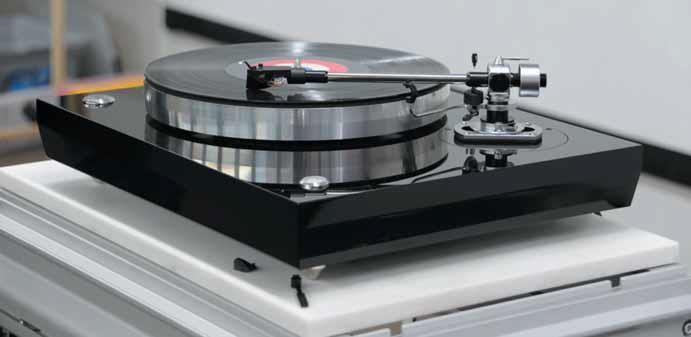The vinyl format is here to stay

Vince Hamilton remembers at the age of 13 falling in love with music and, in particular, vinyl. In fact, so hard did he fall that he has since spent a significant portion of his life trying to build the perfect turntable.
“Listening to records has always been a part of my life, and since my teenage years my love for vinyl has never waned. In fact, I am strongly of the opinion that the record player is still the pinnacle of highfidelity sources. Nothing quite matches the lifelike presence and accurate sound reproduction of vinyl,” he says.
ADVERTISEMENT
“During the 1980s I started collecting turntables and pulling them to pieces to see how they worked.
“This was back when digital audio was first introduced. I know that the sound quality has improved since then, but back in those days I couldn’t see any sense in throwing away my vinyl. The sound wasn’t as good, and I still don’t think it’s as good, so I stayed with vinyl.”
It was a move that appears to have paid off. As more and more people adopted the new format and abandoned their old vinyl records, Vince says he was able to purchase popular LPs for as little as $1. At the peak of his collection, he reportedly had more than 3,000 records.
“I was able to increase my vinyl collection threefold at a fraction of the cost,” he says.
“I’ve gotten rid of some over the years that I just didn’t listen to, but I still have thousands at home.”
After teaching himself the inner workings of turntables, Vince started to do repair work for various shops and individuals. In the back of his mind, though, was the lingering dream of one day creating his own record players. Then, in March 2002, that dream came true and Once Analog was born.
“Since then, I’ve made about 50 turntables, all by hand from my workshop at home,” he says.
“Unfortunately, the players have turned out to be a lot more expensive than I originally thought. In the beginning I thought I could build a high quality turntable affordably and sell it to enthusiasts, but it didn’t quite work out like that. Now, a basic turntable costs $7,500 and that doesn’t include the arm.
“It’s quite an expensive unit, but I’ve had terrific feedback from the people who have bought Once Analog turntables. I wish I could somehow halve the price, but I just can’t.”
Vince says that while you could purchase a reasonable second hand car for that amount of money, the price can be justified because he doesn’t skimp on anything.
“Everything except the platter and bearing housing is constructed from 316 stainless steel, which is not cheap to buy. The platter is high grade aluminium, which doesn’t corrode – it keeps its beauty over the years. “Ultimately my goal was to create a record player of the highest quality; where the materials and finish would be paramount. I believed that such a player, incorporating engineering features not found anywhere else, would shed new light on analogue audio systems.”
Once Analog’s turntables are built around a different concept to traditional suspended sub-chassis designs, without compromising on sound quality.
“My record players are not produced in quantity. They are meticulously hand-crafted and finished one at a time,” Vince says.
“Only the best of materials are used, predominately stainless steel for the machined components and mediumdensity craftwood for the plinths.”
In particular, the materials that contribute to the players’ remarkable sound quality are the silicone damped spindle; bearing housing isolation cylinder made from MS nylon; composite plinth construction, with acrylic inlay; machined cast-lead motor chamber; and, the one piece platter design, weighing 4kg.
“Over the past 10 years, my turntables have evolved to a point where I don’t think there’s anything else I can really do to improve them,” Vince says.
“It took about three years to get the products to where I wanted them – a marvellous sounding turntable that is incredibly reliable.
“The biggest difference between the first and current models is mainly the motor. I played around with several different motors, the power supply and getting the plinth right, which was probably the biggest hassle.
“I found early on that it is actually the plinth the determines the overall sound of the turntable. I put a lot of work into it and tried many different glues, but they all affected the sound and the overall pitch.”
These days, Once Analog turntables are belt-driven using a high-torque, low noise DC motor and Once Vari- Drive external power supply. The motor represents a new design concept – non-cogging and iron-less, giving much smoother and more efficient operation with less vibration. The motor features a highly-polished, stainless-steel pulley and is carefully mounted using a special stainless steel mounting plate. The motor is seated in a well machined, die-cast lead chamber. DC power for the motor is provided by the Vari-Drive electronically regulated power supply. A rotary switch selects motor speed with fine adjustment by means of two screwdriver presets on the back panel.
Overall, despite the cost, Vince is happy to say that his dream has become a reality.
“Once Analog really is an once-in-alifetime opportunity,” he says.
“For that reason, my turntables will never be mass produced and they’ll be available for as long as I’m alive.”
After all, opportunity knocks but once.
-
ADVERTISEMENT
-
ADVERTISEMENT

